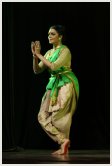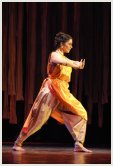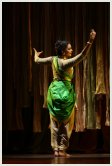 |
 |
 |
 |
 |
 |
 |
 |
 |
|
Home | Credits | Synopsis | Critics Speak | Photo Gallery | Calendar of Performances
Faces...blessed unrest Why can I remember your smile, feel your warmth, smell your skin, but not see your face? I have not striven to forget. My heart remembers the pleasure of you. I can see you taking shape in my mind - yet I cannot see your face… Come back to me. Let me trace the contours of your jaw, run my fingers over your brow, etch the bridge of your nose in my soul's memory, so that when you go away again, this time, I don't forget. FACES is a presentation of some of the most familiar and loved personas from our cultural tapestry. Portraying varied sentiments, these FACES together traverse a spectrum of emotions, to finally surrender to infinite bliss. The Face of Compassion Raga: Sama The Face of Rage Traditional Sanskrit Chant Raga: Punnakavarali The Forgotten Face Raga: Jhonpuri Timeless Faces Raga: Brindavana Saranga The Face of Blissful Surrender Raga: Brindavani FACES brings together the skills of Anita's long-time collaborators Sandhya Raman (costume design), Mithran Devanesen (direction and lighting design) and the music of Anil Srinivasan. Joining the team as dramaturg is Aparna, who has worked with contemporary dance theater in Germany. Notes on FACES Anita Ratnam Most creations find their inspiration in a fleeting word, image or moment. That is how FACES, too, was born. There are the familiar archetypes, but there is also that blurring of lines between them. "These faces were already there – have always been," says Anita. "But they have been recognized as personalities rather than emotions. So when you look at them just as faces, they become easier to relate to, the emotion becomes personal." The use of theatrical stage movement and tools links the faces together, the music stays true to each, and the evening thus becomes an exploration of the range of emotion one is capable of. "Looking past the aura of these cultural icons and finding the recognizable feelings that drive us all, that connect them to us and each other, that's what FACES is about." Anil Srinivasan Musically, FACES opens itself up to variety in choice of styles, showcasing different sources. A striking feature of Anil Srinivasan's musical arrangement for FACES is the usage of traditional Carnatic music compositions sung as they are, not specifically tailor-made to suit set choreography or stage directions. This frees the musical execution from shackles of "made to order" music. So when Sikkil Gurucharan sings, for example, the song is not structured to choreographic requirements, but rather the choreography uses its natural flow. This, to Anil, is the idea of poetry in motion – the music and the dance are simultaneous deliveries. "The treatment of melody with different layers of sound = different moods/expressions conveyed through body movement," says Anil. And he plays with that in such a way that niraval singing is accompanied by a deliberately constructed harmonic base each, for each different treatment of the phrasing. In Anil's arrangements the silence is as important as the sound. Punctuating the music without puncturing it, silence creates space for thinking, absorbing the moment, before the next begins. And this is what the music should allow for. "This is what FACES is all about," he says. "The silence allows the mind to ponder, and form a coherent thought before being rushed into the next face/movement. The dance lies ultimately in the rasanabhuti of silence." Sandhya Raman Sandhya has designed Anita's dance costumes for so many years now; she knows exactly what suits her body, her personality and her movement. As with every new production, the creative work began with a meeting to discuss the theme of the new work and understand what was required of the costumes. Then Sandhya began to interpret concept into fabric. "The first visual image I had was that of soft wraps," she says, "This is contemporary imaginative dialogue between the dancer and the audience, and not classical work, so I wanted to bring out the classical grace of the feminine image without the heavy embellishment of traditional costumes." So the look of the costumes for this production is created with wraps and drapes, rendered elegant by their generous length and then completed with carefully chosen accessories. The colors range from fresh, light green and chrome yellow to copper gold and crystal-studded organza Benaras cutwork. A tussar-toned shell stays constant underneath while the different drapes follow the progressions in the dance. "You will find the grace of the Bengal drape, the flow of northern Kathak and the assertion of masculine energy, each contributing to the continuity of the evening and building up to its conclusion." Aparna For all the commonalities between traditions of dance and theater around the world, there also are the differences. So while collaborative work is exciting, there is an underlying need to respect, if not totally understand, the media that one is working with. "My perception of Bharatanatyam is untrained and inexperienced," says Aparna. "So in this production, that frees my eye from convention and allows me to play with the theatricality of the theme, dramatize movement and create different spaces." Every myth is open to interpretation, every story can be told in infinite ways. "Eventually, with the usage of theatrical stage movement and text to corresponding sound and light, I want find a language that translates into a dramatic yet intimate of telling these stories." |